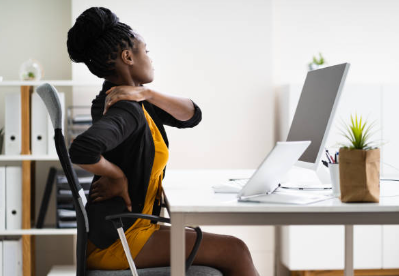Sitting at the Office All Day Seems to Cause Back Pain. What Can I Do?
 An obvious solution is to get up from the sitting position as often as possible. Move around and stretch at regular intervals. The spine is designed to move around freely so that the vertebrae that make up the spinal column don’t compress and rub together.
An obvious solution is to get up from the sitting position as often as possible. Move around and stretch at regular intervals. The spine is designed to move around freely so that the vertebrae that make up the spinal column don’t compress and rub together.
But often this solution may not be possible because your day gets busy, or office circumstances don’t permit you to regularly get up and move about.
Here are some tips to help meet the challenge:
Think About Your Posture
Bad posture while sitting, such as slouching forward too much or leaning too far back, can create pressure points. These poor posture positions constrict the nerves and blood vessels in the back, which can result in pain and problems with the joints, muscles, and discs.
Sitting in an upright position can make a positive difference. Even if your back pain isn’t caused by poor posture, it can be made worse by it.
But even if you can maintain a good sitting position, try to regularly shift your sitting positions so that stresses are distributed across your body more evenly.
Think About Your Chair
Make sure that you use a chair with good lumbar support. This will help keep the natural curvature of the lumbar region of the spine. Make sure that your chair also has a height adjustment knob.
Your chair should be adjusted so that your legs rest flat on the floor with your upper body and the top of your legs at about a 90° angle.
Think About Your Desk
Ideally, when using your keyboard, your elbows should be at your sides and your upper and lower arms should form a 90° angle. Adjust the position of the keyboard on your desk so your arms are not strained in an awkward position.
Also, consider a Sit-Stand Desk. They have been shown to help reduce fatigue and back strain by alternating sitting and standing.
Think About Computer Monitor Height
When your computer monitor is below the level of your eyes, you’ll tend to roll your neck forward in order to be able to look down at it. You may also roll your shoulders and slouch your entire upper body. (This is what most of us do while looking at our phones. This “text neck syndrome” is starting to cause big problems for some.)
If you sit up straight in your chair, your monitor should be positioned so it’s directly in front of your eyes. If you don’t have an adjustable stand on your monitor something as simple as a box or book underneath the stand can help you position the monitor optimally.
Strengthen Your Core Muscles
Don’t underestimate the value of what are called the core muscles. These are the muscles that include the ones on your sides and in your back, hips, abdomen, and buttocks. If they are weak, they may not be supporting your spine well enough, which can result in back pain. If you make these muscles stronger, they can help lessen the pain as they reduce the strain on your back.
There are a variety of different stretching and exercise routines that can help strengthen the core muscles. You may want to get the assistance of a physical therapist or coach. Here are a few resources.
Also, keep in mind that maintaining a healthy body weight will help relieve stress on your spine when sitting. Belly fat can press against your lower spine and contort it when you sit. Adopting a healthier diet and a regular exercise regime that helps you lose weight can make a difference.
Here’s Another Reason to Stay Moving – Pinched Nerves
Sitting for an extended amount of time can create extra pressure on the back of your body, causing it to contract and compress on itself. This can lead to pinched nerves, which can trigger symptoms like neck pain, back pain, sciatic nerve pain, as well as other trigger points within your nerve clusters.
Left untreated, pinched nerves can progress from acute pain to permanent nerve damage because of the consistent strain on your nerves. This can also lead to a loss of sensation in the limbs, general numbness, or weakness in the arms and legs.
Don’t Sleep on It!
Finally, be aware that if you go straight to sleep after sitting down all day, your body will tend to mimic the posture you had while you were sitting in your chair. This can have two negative consequences: it keeps your body from stretching after being stuck in one position for so long, and it decreases the quality of sleep that you get.
To help manage the pain that can come from sitting all day, try:
- Adding more pillows
- Adjusting your mattress,
- Getting a weighted blanket
This may help regain the natural curvature of the spine.
References
- https://www.nhs.uk/live-well/healthy-body/how-to-sit-correctly/
- https://www.ncbi.nlm.nih.gov/pmc/articles/PMC3404815/
- https://www.ncbi.nlm.nih.gov/pubmed/24285335
- https://www.ncbi.nlm.nih.gov/pubmed/25168375
- https://www.ncbi.nlm.nih.gov/pubmed/26584856
